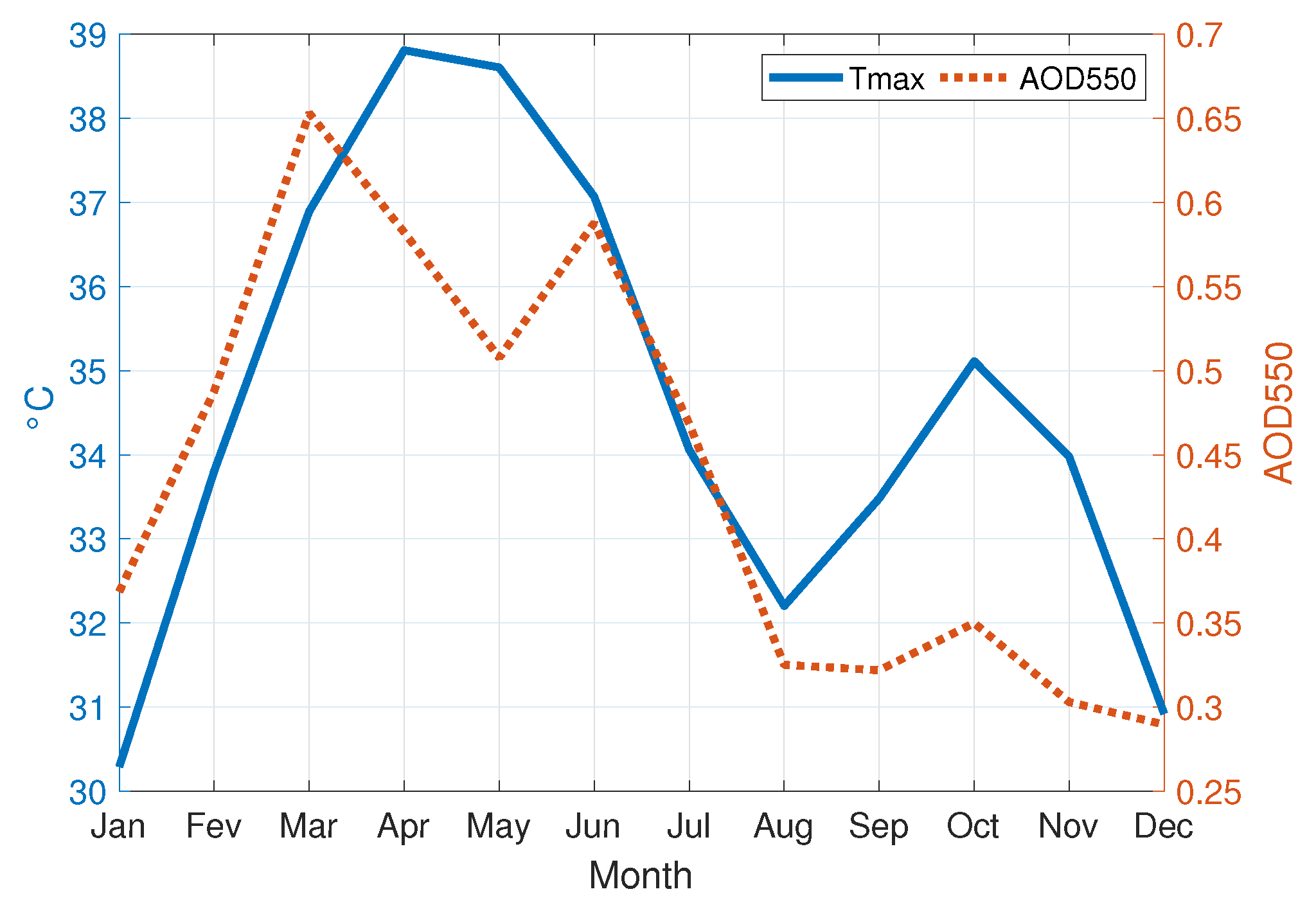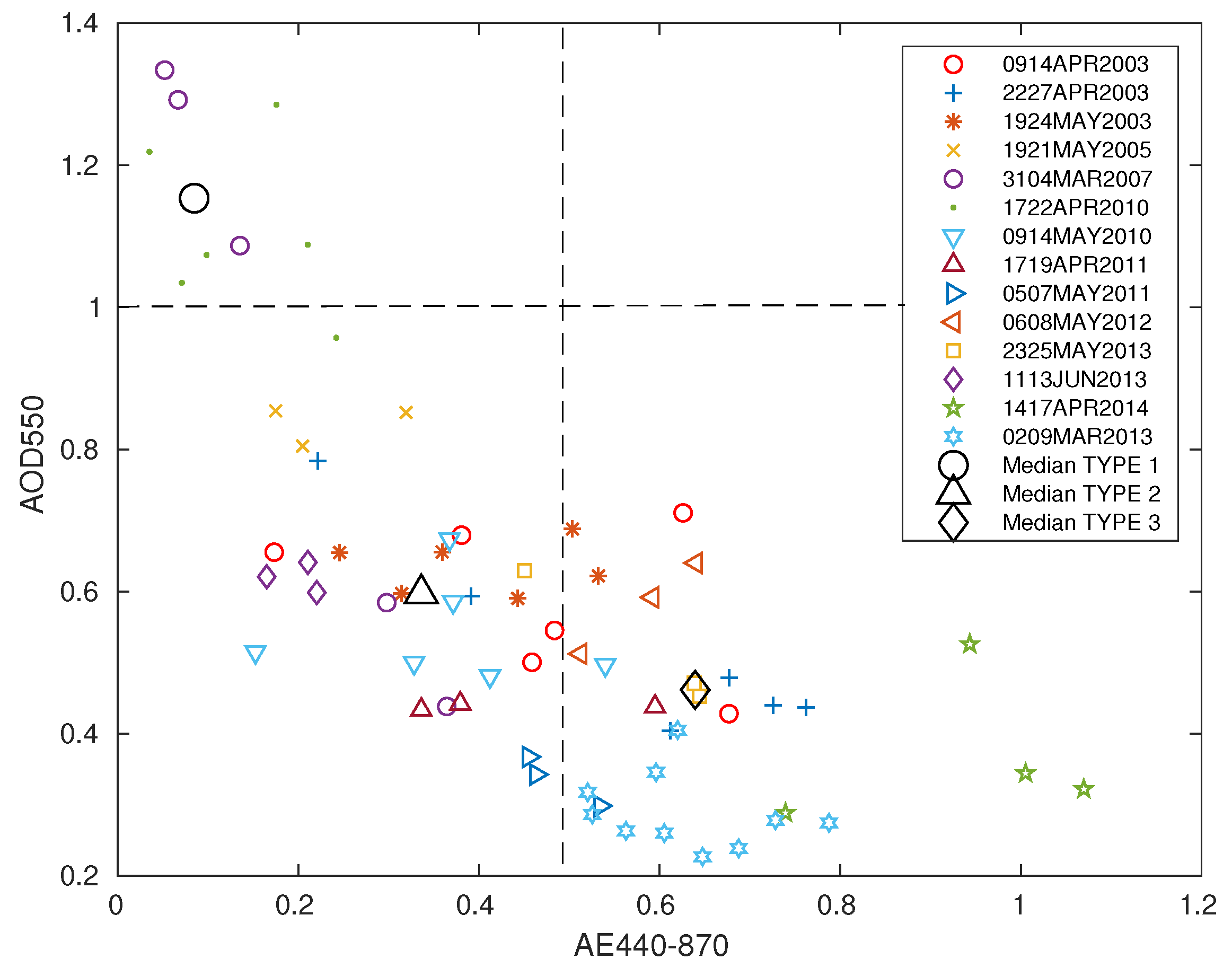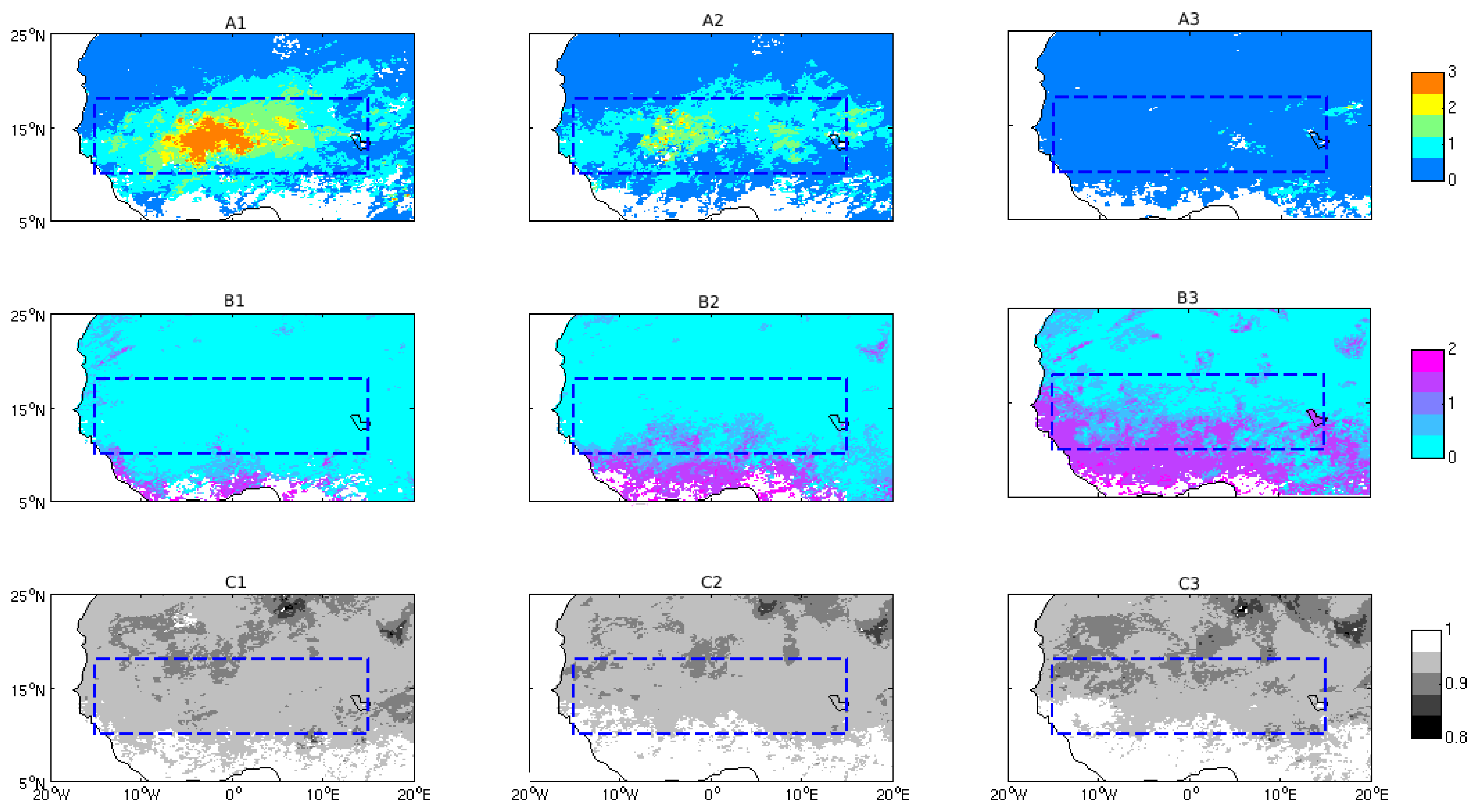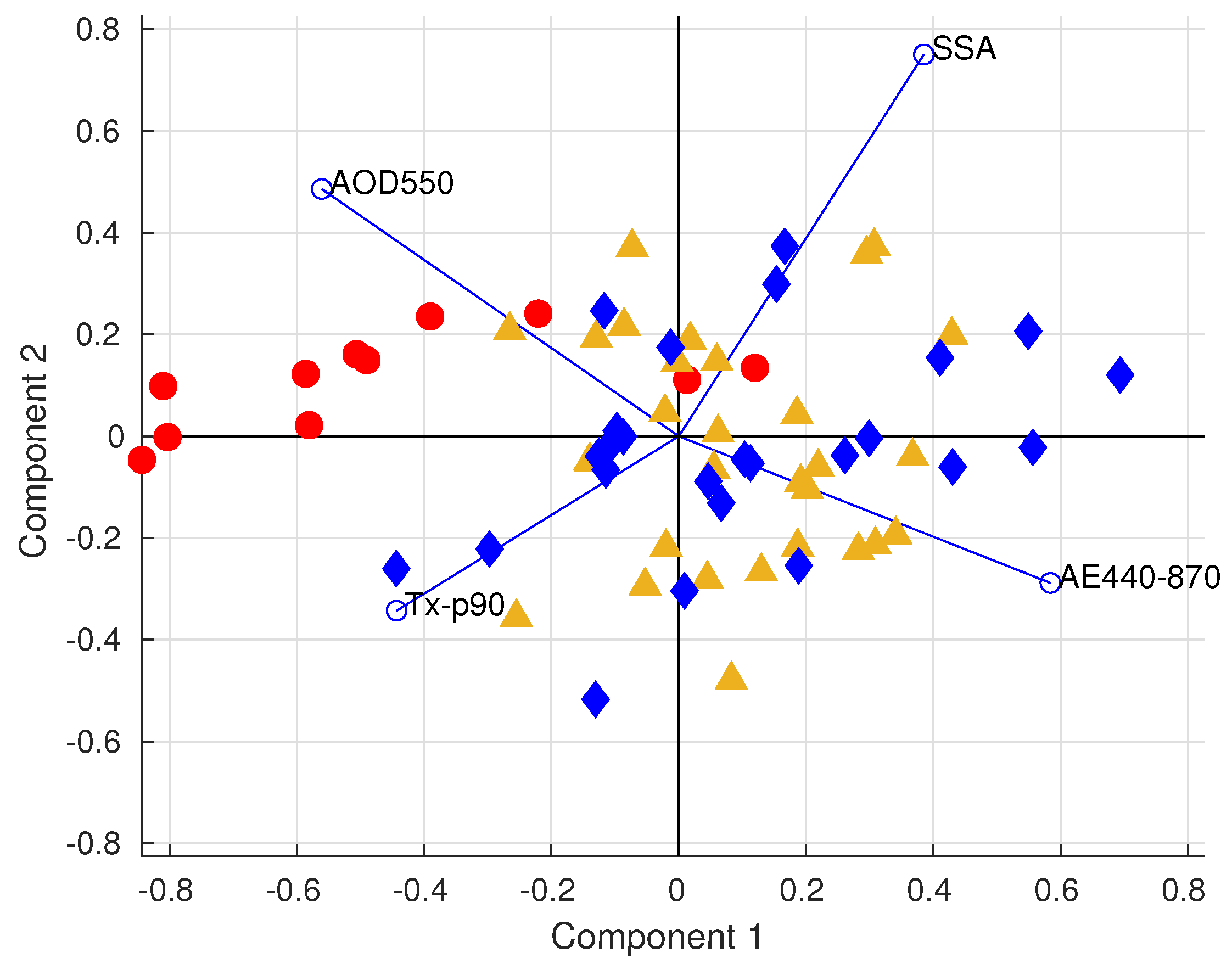Assessments for the Effect of Mineral Dust on the Spring Heat Waves in the Sahel
Abstract
:1. Introduction
2. Presentation of the Datasets
2.1. Atmospheric Temperature Dataset from Reanalysis
2.2. Aerosol Datasets from Remote Sensing and In Situ Measurements
2.2.1. MODIS Products
2.2.2. Aerosol Optical Thickness from the AErosol RObotic Network
2.2.3. PM Mass Concentrations at the Surface from the Sahelian Dust Transect
3. Study Area and Methods
3.1. Study Area Description
3.2. Heat Wave Definition and Categorization
4. Results
4.1. Aerosol Characteristics during the Spring Heat Waves
4.2. Relationship between Heat Wave Intensity and Aerosol Type and Quantity
5. Discussion
5.1. Assumption on the Aerosol Vertical Distribution: Focus on Type 1 Heat Waves
5.2. Analysis of the Specific Case of the Historic 2010 Heat Wave in the Sahel Based on PM Mass Concentrations Products from Reanalysis
6. Conclusions and Perspectives
Author Contributions
Funding
Institutional Review Board Statement
Informed Consent Statement
Data Availability Statement
Acknowledgments
Conflicts of Interest
References
- Luterbacher, J.; Dietrich, D.; Xoplaki, E.; Grosjean, M.; Wanner, H. European seasonal and annual temperature variability, trends, and extremes since 1500. Science 2004, 303, 1499–1503. [Google Scholar] [CrossRef] [PubMed]
- Schneidereit, A.; Schubert, S.; Vargin, P.; Lunkeit, F.; Zhu, X.; Peters, D.H.W.; Fraedrich, K. Large-scale flow and the long-lasting blocking high over Russia: Summer 2010. Mon. Weather. Rev. 2004, 140, 2967–2981. [Google Scholar] [CrossRef]
- Sy, I.; Cissé, B.; Ndao, B.; Touré, M.; Diouf, A.A.; Sarr, M.A.; Ndiaye, O.; Ndiaye, Y.; Badiane, D.; Lalou, L.; et al. Heat waves and health risks in the northern part of Senegal: Analysing the distribution of temperature-related diseases and associated risk factors. Environ. Sci. Pollut. Res. 2022, 29, 83365–83377. [Google Scholar] [CrossRef]
- Moron, V.; Oueslati, B.; Pohl, B.; Rome, S.; Janicot, S. Trends of mean temperatures and warm extremes in northern tropical Africa (1961–2014) from observed and PPCA-reconstructed time series. J. Geophys. Res. Atmos. 2016, 121, 5298–5319. [Google Scholar] [CrossRef]
- Oueslati, B.; Pohl, B.; Moron, V.; Rome, S.; Janicot, S. Characterization of Heat Waves in the Sahel and Associated Physical Mechanisms. J. Clim. 2017, 30, 3095–3115. [Google Scholar] [CrossRef]
- Fontaine, B.; Janicot, S.; Monerie, P.A. Recent changes in air temperature, heat waves occurrences and atmospheric circulation in Northern Africa. J. Geophys. Res. 2004, 118, 8536–8552. [Google Scholar] [CrossRef]
- Sousa, P.M.; Barriopedro, D.; Ramos, A.M.; García-Herrera, R.; Espírito-Santo, F.; Trigo, R.M. Saharan air intrusions as a relevant mechanism for Iberian heatwaves: The record breaking events of August 2018 and June 2019. Weather. Clim. Extrem. 2019, 26, 100224. [Google Scholar] [CrossRef]
- Valenzuela, A.; Costa, M.J.; Guerrero-Rascado, J.L.; Bortoli, D.; Olmo, F.J. Solar and thermal radiative effects during the 2011 extreme desert dust episode over Portugal. Atmos. Environ. 2017, 148, 16–29. [Google Scholar] [CrossRef]
- Osborne, S.R.; Baran, A.J.; Johnson, B.T.; Haywood, J.M.; Hesse, E.; Newman, S. Short-wave and long-wave radiative properties of Saharan dust aerosol. Q. J. R. Meteorol. Soc. 2011, 137, 1149–1167. [Google Scholar]
- Bohren, C.F.; Donald, R.H. Absorption and Scattering of Light by Small Particles; John Wiley & Sons: Hoboken, NJ, USA, 2008. [Google Scholar]
- Highwood, E.J.; Ryder, C.L. Mineral Dust: A Key Player in the Earth System, 1st ed.; Knippertz, P., Stuut, J.B., Eds.; Springer Science + Business Media: Dordrecht, The Netherlands, 2014; pp. 267–283. [Google Scholar] [CrossRef]
- Papachristopoulou, K.; Raptis, I.P.; Gkikas, A.; Fountoulakis, I.; Masoom, A.; Kazadzis, S. Aerosol optical depth regime over megacities of the world. Atmos. Chem. Phys. 2022, 22, 15703–15727. [Google Scholar] [CrossRef]
- Meloni, D.; di Sarra, A.; Brogniez, G.; Denjean, C.; De Silvestri, L.; Di Iorio, T.; Formenti, P.; Gómez-Amo, J.L.; Gröbner, J.; Kouremeti, N.; et al. Determining the infrared radiative effects of Saharan dust: A radiative transfer modelling study based on vertically resolved measurements at Lampedusa. Atmos. Chem. Phys. 2018, 18, 4377–4401. [Google Scholar] [CrossRef]
- Quijano, A.L.; Sokolik, I.N.; Toon, O.B. Radiative heating rates and direct radiative forcing by mineral dust in cloudy atmospheric conditions. J. Geophys. Res. Atmos. 2000, 105, 12207–12219. [Google Scholar] [CrossRef]
- Dee, D.P.; Uppala, S.M.; Simmons, A.J.; Berrisford, P.; Poli, P.; Kobayashi, S.; Andrae, U.; Balmaseda, M.A.; Balsamo, G.; Bauer, P.; et al. The ERA-Interim reanalysis: Configuration and performance of the data assimilation system. Q. J. R. Meteorol. Soc. 2011, 137, 553–597. [Google Scholar] [CrossRef]
- Ceccherini, G.; Russo, S.; Ameztoy, I.; Marchese, A.F.; Carmona-Moreno, C. Heat waves in Africa 1981–2015, observations and reanalysis. Nat. Hazards Earth Syst. Sci. 2017, 17, 115–125. [Google Scholar] [CrossRef]
- Hsu, N.C.; Jeong, J.M.; Bettenhausen, C.; Sayer, A.M.; Hansell, R.; Seftor, C.S.; Huang, J.; Tsay, S.C. Enhanced Deep Blue aerosol retrieval algorithm: The second generation. J. Geophys. Res. Atmos. 2013, 118, 9296–9315. [Google Scholar] [CrossRef]
- Shi, J.H.; Gao, H.W.; Zhang, J. Examination of causative link between a spring bloom and dry/wet deposition of Asian dust in the Yellow Sea. China J. Geophys. Res. 2012, 117, D17304. [Google Scholar] [CrossRef]
- Holben, B.N.; Tanre, D.; Smirnov, A.; Eck, T.F.; Slutsker, I.; Abuhassan, N.; Newcomb, W.W.; Schafer, J.; Chatenet, B.; Lavenue, F.; et al. An emerging ground-based aerosol climatology: Aerosol optical depth from AERONET. J. Geophys. Res. 2001, 106, 12067–12097. [Google Scholar] [CrossRef]
- Dubovik, O.; King, M. A flexible inversion algorithm for retrieval of aerosol optical properties from sun and sky radiance measurements. J. Geophys. Res. 2000, 105, 20673–20696. [Google Scholar] [CrossRef]
- Dubovik, O.; Smirnov, A.; Holben, B.; King, M.; Kaufman, Y.; Eck, T.; Slutsker, I. Accuracy assessments of aerosol optical properties retrieved from Aerosol Robotic Network (AERONET) sun and sky radiance measurements. J. Geophys. Res. 2000, 105, 9791–9806. [Google Scholar] [CrossRef]
- Marticorena, B.; Chatenet, B.; Rajot, J.L.; Traore, S.; Coulibaly, M.; Diallo, A.; Koné, I.; Maman, A.; NDiaye, T.; Zakou, A. Temporal variability of mineral dust concentrations over West Africa: Analyses of a pluriannualmonitoring from the AMMA Sahelian dust transect. Atmos. Chem. Phys. 2010, 10, 8899–8915. [Google Scholar] [CrossRef]
- Rome, S.; Oueslati, B.; Moron, V.; Pohl, B.; Diedhiou, A. Les vagues de chaleur au sahel: Définition et principales caractéristiques spatio-temporelles (1973–2014). In Proceedings of the 29ème Colloque de l’Association Internationale de Climatologie, Besançon, France, 4–7 July 2016; pp. 345–350, <hal-01360076>. [Google Scholar]
- Vizy, E.K.; Cook, K.H. Mid-twenty-first-century changes in extreme events over northern and tropical Africa. J. Clim. 2012, 25, 5748–5767. [Google Scholar] [CrossRef]
- Oueslati, B.; Camberlin, P.; Zoungrana, J.; Roucou, P.; Diallo, S. Variability and trends of wet season temperature in the Sudano-Sahelian zone and relationships with precipitation. Clim. Dyn. 2018, 50, 1067–1090. [Google Scholar] [CrossRef]
- Schepanski, K.; Tegen, I.; Macke, A. Saharan dust transport and deposition towards the tropical northern Atlantic. Atmos. Chem. Phys. 2004, 9, 1173–1189. [Google Scholar] [CrossRef]
- Martiny, N.; Chiapello, I. Assessments for the impact of mineral dust on the meningitis incidence in West Africa. Atmos. Environ. 2013, 70, 245–253. [Google Scholar] [CrossRef]
- Prospero, J.M.; Ginoux, P.; Torres, O.; Nicholson, S.E.; Gill, T.E. Environmental characterisation of global sources of atmospheric soil dust identified with the Nimbus 7 Total Ozone Mapping Spectrometre (TOMS) absorbing aerosol product. Rev. Geophys. 2002, 40, 31. [Google Scholar] [CrossRef]
- Haywood, J.M.; Pelon, J.; Formenti, P.; Bharmal, N.; Brooks, M.; Capes, G.; Chazette, P.; Chou, C.; Christopher, S.; Coe, H.; et al. Overview of the dust and biomass-burning experiment and African Monsoon Multidisciplinary Analysis special observing period-0. J. Geophys. Res. Atmos. 2008, 113, 20. [Google Scholar] [CrossRef]
- Martiny, N.; Roucou, P. Regional dust modeling for the onset of the meningitis outbreaks in Burkina Faso. In Proceedings of the 3rd Iberian Meeting on Aerosol Science and Technology, Oral, Conférence Invitée, Elche, Alicante, Spain, 29 June–1 July 2015. [Google Scholar]
- Russo, S.; Dosio, A.; Graversen, R.G.; Sillmann, J.; Carrao, H.; Dunbar, M.B.; Singleton, A.; Montagna, P.; Barbola, P.; Vogt, J.V. Magnitude of extreme heat waves in present climate and their projection in a warming world. J. Geophys. Res. Atmos. 2014, 119, 12500–12512. [Google Scholar] [CrossRef]
- Ginoux, P.; Prospero, J.M.; Gill, E.T.; Hsu, N.C.; Zhao, M. Global-scale attribution of anthropogenic andnatural dust sources and their emission rates based on MODIS Deep Blue aerosol products. Rev. Geophys. 2012, 50, RG3005. [Google Scholar] [CrossRef]
- Eck, T.F.; Holben, B.N.; Reid, J.S.; Dubovik, O.; Smirnov, A.; O’Neill, N.T.; Slutsker, I.; Kinne, S. Wavelength dependence of the optical depth of biomass burning, urban and desert dust aerosols. J. Geophys. Res. 1999, 104, 31333–31349. [Google Scholar] [CrossRef]
- Zhang, X.; Alexander, L.; Hegerl, G.C.; Jones, P.; Tank, A.K.; Peterson, T.C.; Trewin, B.; Zwiers, F.W. Indices for monitoring changes in extremes based on daily temperature and precipitation data. WIREs Clim. Chang. 2011, 2, 851–870. [Google Scholar] [CrossRef]
- ETCCDI (Expert Team on Climate Change Detection and Indices). Available online: http://etccdi.pacificclimate.org/list_27_indices.html (accessed on 29 January 2013).
- Deroubaix, A.; Martiny, N.; Chiapello, I.; Marticorena, B. Suitability of OMI aerosol index to reflect mineral dust surface conditions: Preliminary application for studying the link with meningitis epidemics in the Sahel, in revision. Remote. Sens. Environ. J. 2013, 133, 116–127. [Google Scholar] [CrossRef]
- Engelstaedter, S.; Tegen, I.; Washington, R. North African dust emissions and transport. Earth Sci. Rev. 2006, 79, 73–100. [Google Scholar] [CrossRef]
- Roberts, G.; Wooster, M.J.; Lagoudakis, E. Annual and diurnal african biomass burning temporal dynamics. Biogeosciences 2009, 6, 849–866. [Google Scholar] [CrossRef]
- Di Biagio, C.; Formenti, P.; Balkanski, Y.; Caponi, L.; Cazaunau, M.; Pangui, E.; Journet, E.; Nowak, S.; Andreae, M.O.; Kandler, K.; et al. Complex refractive indices and single-scattering albedo of global dust aerosols in the shortwave spectrum and relationship to size and iron content. Atmos. Chem. Phys. 2019, 19, 15503–15531. [Google Scholar] [CrossRef]
- Kaufman, Y.J.; Tanré, D.; Dubovik, O.; Karnieli, A.; Remer, L.A. Absorption of sunlight by dust as inferred from satellite and ground-based remote sensing. Geophys. Res. Lett. 2001, 28, 1479–1482. [Google Scholar] [CrossRef]
- Barbier, J.; Guichard, F.; Bouniol, D.; Couvreux, F.; Roehrig, R. Detection of Intraseasonal Large-Scale Heat Waves: Characteristics and Historical Trends during the Sahelian Spring. J. Clim. 2017, 31, 61–80. [Google Scholar] [CrossRef]
- Sayer, J.; Sunderl, T.; Ghazoul, J.; Pfund, J.L.; Sheil, D.; Meijaard, E.; Buck, L.E. Ten principles for a landscape approach to reconciling agriculture, conservation, and other competing land uses. Proc. Natl. Acad. Sci. USA 2013, 110, 8349–8356. [Google Scholar] [CrossRef]
- Jolliffe, I.T.; Cadima, J. Principal Component Analysis: A Review and Recent Developments. Philos. Trans. Ser. A Math. Phys. Eng. Sci. 2016, 374, 20150202. [Google Scholar] [CrossRef]
- Léon, J.F.; Derimian, Y.; Chiapello, I.; Tanré, D.; Podvin, T.; Chatenet, B.; Diallo, A.; Deroo, C. Aerosol vertical distribution and optical properties over M’Bour (16.96° W; 14.39° N), Senegal from 2006 to 2008. Atmos. Chem. Phys. 2009, 9, 9249–9261. [Google Scholar] [CrossRef]
- Jeong, M.J.; Hsu, N.C. Retrievals of aerosol single-scattering albedo and effective aerosol layer height for biomass-burning smoke: Synergy derived from “A-Train” sensors. Geophys. Res. Lett. 2008, 35, L24801. [Google Scholar] [CrossRef]
- Inness, A.; Ades, M.; Agusti-Panareda, A.; Barré, J.; Benedictow, A.; Blechschmidt, A.M.; Dominguez, J.J.; Engelen, R.; Eskes, H.; Flemming, J.; et al. The CAMS reanalysis of atmospheric composition. Atmos. Chem. Phys. 2018, 19, 3515–3556, Discussions 1–55. [Google Scholar] [CrossRef]
- Tegen, I.; Fung, I. Modeling of mineral dust in the atmosphere: Sources, transport, and optical thickness. J. Geophys. Res. 1994, 99, 22897–22914. [Google Scholar] [CrossRef]
- Holben, B.N.; Eck, T.F.; Slutsker, I.; Tanré, D.; Buis, J.P.; Setzer, A.; Vermote, E.; Reagan, J.A.; Kaufman, Y.; Nakajima, T.; et al. AERONET-A Federated Instrument Network and Data Archive for Aerosol Characterization. Rem. Sens. Environ. 1998, 66, 1–16. [Google Scholar] [CrossRef]
- Smirnov, A.; Holben, B.; Eck, T.; Dubovik, O.; Slutsker, I. Cloud screening and quality control algorithms for the AERONET database. Remote Sens. Environ. 2000, 73, 337–349. [Google Scholar] [CrossRef]
- Sambou, M.J.G.; Pohl, B.; Janicot, S.; Landry Famien, A.M.; Roucou, P.; Badiane, D.; Gaye, A.T. Heat waves in spring from Senegal to Sahel: Evolution under climate change. Int. J. Climatol. 2021, 41, 6238–6253. [Google Scholar] [CrossRef]
- Ji, Z.; Wang, G.; Yu, M.; Pal, J.S. Potential climate effect of mineral aerosols over West Africa: Part II—contribution of dust and land cover to future climate change. Clim. Dyn. 2018, 50, 2335–2353. [Google Scholar] [CrossRef]
- Léon, J.-F.; Martiny, N.; Merlet, S. A Multi Linear Regression Model to Derive Dust PM10 in the Sahel Using AERONET Aerosol Optical Depth and CALIOP Aerosol Layer Products. Remote Sens. 2020, 12, 3099. [Google Scholar] [CrossRef]
- Largeron, Y.; Guichard, F.; Roehrig, R.; Couvreux, F.; Barbier, J. The April 2010 North African heatwave: When the water vapor greenhouse effect drives nighttime temperatures. Clim. Dyn. 2020, 54, 3879–3905. [Google Scholar] [CrossRef]






| Date | Duration | Mean T | Type |
|---|---|---|---|
| 9–14 APR 2003 | 6 | 41.5 | 2 |
| 22–27 APR 2003 | 6 | 40.8 | 3 |
| 19–24 MAY 2003 | 6 | 40.4 | 3 |
| 19–21 MAY 2005 | 3 | 40.3 | 2 |
| 31–04 MAR 2007 1 | 5 | 40.7 | 1 |
| 17–22 APR 2010 | 6 | 41.1 | 1 |
| 09–14 MAY 2010 | 6 | 40.4 | 2 |
| 17–19 APR 2011 | 3 | 40.4 | 2 |
| 5–7 MAY 2011 | 3 | 40.6 | 3 |
| 6–8 MAY 2012 | 3 | 40.6 | 3 |
| 23–25 MAY 2013 | 3 | 40.7 | 2 |
| 11–13 JUN 2013 | 3 | 39.3 | 2 |
| 2–10 MAR 2013 | 9 | 38.9 | 3 |
| 14–17 APR 2014 | 4 | 40.2 | 3 |
| AOD | AE | SSA | T-P90 | |
|---|---|---|---|---|
| Type 1 | 1.17 | 0.10 | 0.931 | +1.1 |
| Type 2 | 0.60 | 0.35 | 0.938 | +0.5 |
| Type 3 | 0.46 | 0.65 | 0.935 | +0.4 |
| Type 1 HW | 31 March to 4 April 2007 | 17 April to 22 April 2010 | ||
|---|---|---|---|---|
| Sites | Cinzana | Banizoumbou | Cinzana | Banizoumbou |
| MODIS AOD | 3.1 | 0.6 | 3.0 | 2.9 |
| AERONET AOD | 1.6 | 2.7 | 1.5 | 1.0 |
| TEOM PM | 183 | 380 | 1745 | 565 |
| Normal TEOM PM | 144 | 189 | 157 | 214 |
Disclaimer/Publisher’s Note: The statements, opinions and data contained in all publications are solely those of the individual author(s) and contributor(s) and not of MDPI and/or the editor(s). MDPI and/or the editor(s) disclaim responsibility for any injury to people or property resulting from any ideas, methods, instructions or products referred to in the content. |
© 2023 by the authors. Licensee MDPI, Basel, Switzerland. This article is an open access article distributed under the terms and conditions of the Creative Commons Attribution (CC BY) license (https://creativecommons.org/licenses/by/4.0/).
Share and Cite
Niane, P.M.; Martiny, N.; Roucou, P.; Marilleau, N.; Janicot, S.; Gaye, A.T. Assessments for the Effect of Mineral Dust on the Spring Heat Waves in the Sahel. Atmosphere 2023, 14, 1373. https://doi.org/10.3390/atmos14091373
Niane PM, Martiny N, Roucou P, Marilleau N, Janicot S, Gaye AT. Assessments for the Effect of Mineral Dust on the Spring Heat Waves in the Sahel. Atmosphere. 2023; 14(9):1373. https://doi.org/10.3390/atmos14091373
Chicago/Turabian StyleNiane, Papa Massar, Nadège Martiny, Pascal Roucou, Nicolas Marilleau, Serge Janicot, and Amadou Thierno Gaye. 2023. "Assessments for the Effect of Mineral Dust on the Spring Heat Waves in the Sahel" Atmosphere 14, no. 9: 1373. https://doi.org/10.3390/atmos14091373







